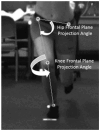Comparison of Inflammatory Biomarkers in Females with and Without Patellofemoral Pain and Associations with Patella Position, Hip and Knee Kinematics, and Pain
- PMID: 40149737
- PMCID: PMC11940318
- DOI: 10.3390/biomedicines13030761
Comparison of Inflammatory Biomarkers in Females with and Without Patellofemoral Pain and Associations with Patella Position, Hip and Knee Kinematics, and Pain
Abstract
Background/Objectives: Patellofemoral pain (PFP) is believed to be a precursor to knee osteoarthritis (OA). The primary purpose of this study was to compare matrix metalloproteinase-9 (MMP-9) levels in young adult females with and without PFP. The secondary purpose was to determine the associations between MMP-9, patella position, hip and knee kinematics, and pain in females with PFP. Methods: Plasma was analyzed for MMP-9. Patellar position was measured using diagnostic ultrasound as the degree of offset (RAB angle) from the deepest aspect of the femoral trochlear groove to the inferior pole of the patella. A positive RAB angle suggested patella lateralization. Hip and knee kinematics during a single-leg squat were measured using 2-dimensional motion analysis and quantified as the dynamic valgus index (DVI), a combined measure of hip and knee motion. A higher DVI suggests increased valgus loading at the patellofemoral joint. Pain was measured using a 10 cm visual analog scale. Results: Females with PFP had significantly higher levels of MMP-9 than controls (72.7 vs. 58.0 ng/mL, p = 0.03). Females with PFP had a significant positive association between MMP-9 and patella lateralization (r = 0.38, p = 0.04), suggesting that greater patellar lateralization may contribute to increased joint inflammation. A significant inverse association was observed between MMP-9 and the DVI (r = -0.50, p = 0.007), indicating that individuals with higher inflammatory marker levels may adopt movement patterns that reduce valgus loading. Conclusions: The significant association between MMP-9 and patella lateralization suggested a potential link between patella alignment and joint inflammation, which may contribute to early joint degeneration. The inverse association between MMP-9 levels and the DVI suggested that subjects with higher MMP-9 levels adjusted their movement pattern as a compensatory mechanism to reduce knee valgus stress to reduce joint degeneration.
Keywords: anterior knee pain; matrix metalloproteinase-9; osteoarthritis.
Conflict of interest statement
The authors declare no conflicts of interest.
Figures



References
-
- Steinmetz J.D., Culbreth G.T., Haile L.M., Rafferty Q., Lo J., Fukutaki K.G., Cruz J.A., Smith A.E., Vollset S.E., Brooks P.M., et al. GBD 2021 Osteoarthritis Collaborators. Global, regional, and national burden of osteoarthritis, 1990–2020 and projections to 2050: A systematic analysis for the Global Burden of Disease Study 2021. Lancet Rheumatol. 2023;5:e508–e522. doi: 10.1016/S2665-9913(23)00163-7. - DOI - PMC - PubMed
-
- Lawrence R.C., Felson D.T., Helmick C.G., Arnold L.M., Choi H., Deyo R.A., Gabriel S., Hirsch R., Hochberg M.C., Hunder G.G., et al. Estimates of the prevalence of arthritis and other rheumatic conditions in the United States. Part II. Arthritis Rheum. 2008;58:26–35. doi: 10.1002/art.23176. - DOI - PMC - PubMed
-
- Vitaloni M., Botto-van Bemden A., Sciortino Contreras R.M., Scotton D., Bibas M., Quintero M., Monfort J., Carné X., de Abajo F., Oswald E., et al. Global management of patients with knee osteoarthritis begins with quality of life assessment: A systematic review. BMC Musculoskelet. Disord. 2019;20:493. doi: 10.1186/s12891-019-2895-3. - DOI - PMC - PubMed
-
- Pazzinatto M.F., Silva D.O., Willy R.W., Azevedo F.M., Barton C.J. Fear of movement and (re)injury is associated with condition specific outcomes and health-related quality of life in women with patellofemoral pain. Physiother. Theory Pract. 2022;38:1254–1263. doi: 10.1080/09593985.2020.1830323. - DOI - PubMed
LinkOut - more resources
Full Text Sources
Miscellaneous

